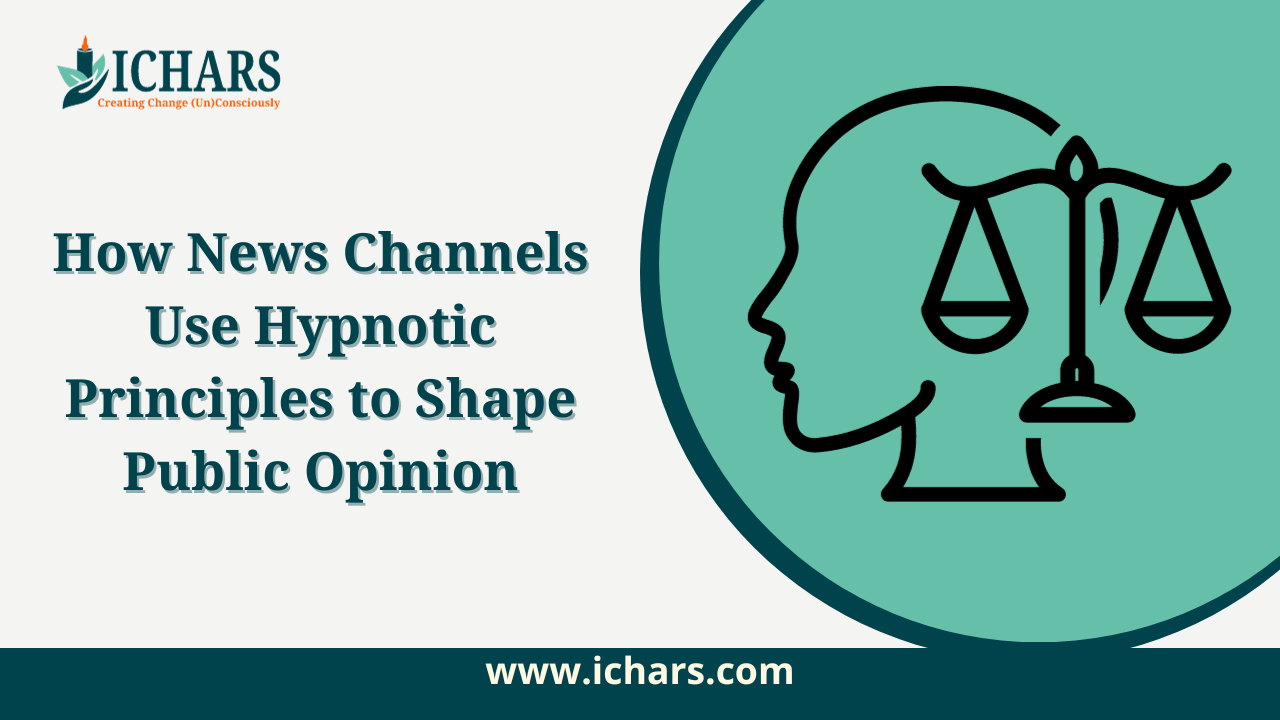Think about the coverage of a natural disaster, where heart-wrenching images and emotive storytelling evoke empathy and anger, directing our emotions and thoughts. Or perhaps reflect on the global pandemic that took place, where the media’s framing of facts, language choices, and expert panel discussions impact not only what we believe but how we perceive reality itself.

These practical examples are just the tip of the iceberg. In the age of information saturation, news channels hold immense sway over public perception. The media, entrusted with the responsibility of providing impartial and factual reporting, often navigates a fine line, occasionally delving into the rfealm of hypnotic principles to engage and influence their audience.
In this article, we’ll delve deeper into the subtle techniques employed by news outlets, shedding light on how they skilfully navigate the complex terrain of public opinion using Hypnotic principles, one story at a time creating an impact on their audience.
The Power of Visuals
One of the most effective tools that news channels use to influence public opinion is the power of visuals. Hypnosis often relies on visual stimuli to induce trance-like states, and news channels employ a similar tactic by using compelling images and videos to capture their audience’s attention. The constant repetition of striking visuals can create an emotional response, which is essential in shaping opinions.
For example, during a political debate or a news segment, channels might repeatedly show images of protests, political rallies, or natural disasters, with dramatic music and overlays. These visual cues can evoke strong emotional responses in viewers, making them more susceptible to adopting the channel’s perspective.
The Importance of Rhythm and Pacing
Hypnotic inductions often involve a soothing and consistent rhythm, and news channels follow a similar principle in their programming. The rhythm and pacing of news broadcasts can have a hypnotic effect on the audience, keeping them engaged and receptive to the content being presented.
For instance, the repetitive nature of news channels, with regular breaks for commercials and transitions between segments, allows viewers to enter a trance-like state where they are more likely to accept the information being presented without question. These rhythms are strategically designed to maintain audience attention and manipulate their opinions.
Language and Suggestion
News channels use language and suggestion to subtly manipulate their audience’s thoughts and opinions. Hypnosis frequently employs the power of suggestion, and news anchors and reporters use suggestive language to influence public perception. They may frame issues in a certain way or use loaded terminology that influences how viewers interpret the news.
For instance, the choice of words like “terrorists” instead of “militants” or “freedom fighters” can drastically alter how viewers perceive a particular group. Such linguistic choices can promote a specific narrative and steer the audience towards a predetermined opinion.
Repetition and Anchoring

Repetition is a fundamental principle of hypnosis, and news channels employ it effectively to reinforce certain ideas or opinions. Repeating information, phrases, or visuals creates a sense of familiarity, making viewers more likely to accept what they see or hear as true.
News channels often use anchoring techniques to create a reference point in viewers’ minds. By frequently referring back to a particular story or image, they anchor that information in the audience’s consciousness, making it a central reference point for discussions and opinions.
Emotional Manipulation
Emotions play a crucial role in hypnotic inductions, and news channels are adept at manipulating emotions to shape public opinion. Whether it’s stirring up anger, fear, or empathy, news outlets use emotional triggers to engage their audience.
For instance, a news story about a tragic event might include interviews with grieving families, showcasing their raw emotions. This emotional connection can lead viewers to empathize with the victims and align with the news channel’s perspective on the issue, thereby influencing their opinion.
Social Proof and Groupthink
Hypnotic principles often rely on the power of social influence, and news channels exploit this by emphasizing social proof and encouraging groupthink. They use tactics like expert interviews, panel discussions, and public opinion polls to make viewers believe that their perspective is widely shared.
When viewers see experts or panelists on news channels agreeing on a particular viewpoint, they may feel compelled to conform to the majority opinion, even if they had reservations initially. This encourages a collective mindset, where individuals are more likely to adopt the consensus opinion presented on the news.
Confirmation Bias
News channels often cater to the confirmation bias of their target audience. Hypnosis leverages the mind’s natural inclination to accept information that aligns with existing beliefs and values. News outlets capitalize on this by providing content that reinforces the biases and preferences of their viewers.
For example, a news channel with a conservative audience may predominantly present stories and viewpoints that align with conservative values, thereby confirming their viewers’ preexisting beliefs. This approach ensures that viewers continue to tune in, as they feel validated and understood by the channel.
To conclude, news channels wield significant influence in shaping public opinion. While the media is expected to provide accurate and objective information, the application of hypnotic principles in news reporting is a contentious issue. The use of visuals, pacing, language, suggestion, repetition, emotional manipulation, and other techniques allows news channels to subtly guide their audience’s perceptions and beliefs.
It is essential for consumers of news to be aware of these tactics and critically evaluate the information they encounter. By understanding how news channels employ hypnotic principles, individuals can become more discerning viewers and make informed decisions about the information they consume and the opinions they form. In an age of information overload, it’s crucial to navigate the news landscape with a critical mind and a discerning eye.

